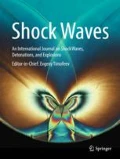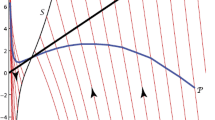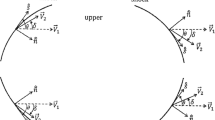Abstract
The radial one-dimensional Euler equations are often rewritten in what is known as the geometric source form. The differential operator is identical to the Cartesian case, but source terms result. Since the theory and numerical methods for the Cartesian case are well-developed, they are often applied without modification to cylindrical and spherical geometries. However, numerical conservation is lost. In this article, AUSM\(^+\)-up is applied to a numerically conservative (discrete) form of the Euler equations labeled the geometric form, a nearly conservative variation termed the geometric flux form, and the geometric source form. The resulting numerical methods are compared analytically and numerically through three types of test problems: subsonic, smooth, steady-state solutions, Sedov’s similarity solution for point or line-source explosions, and shock tube problems. Numerical conservation is analyzed for all three forms in both spherical and cylindrical coordinates. All three forms result in constant enthalpy for steady flows. The spatial truncation errors have essentially the same order of convergence, but the rate constants are superior for the geometric and geometric flux forms for the steady-state solutions. Only the geometric form produces the correct shock location for Sedov’s solution, and a direct connection between the errors in the shock locations and energy conservation is found. The shock tube problems are evaluated with respect to feature location using an approximation with a very fine discretization as the benchmark. Extensions to second order appropriate for cylindrical and spherical coordinates are also presented and analyzed numerically. Conclusions are drawn, and recommendations are made. A derivation of the steady-state solution is given in the Appendix.




















Similar content being viewed by others
References
Tannehill, J., Anderson, D., Pletcher, R.: Computational Fluid Mechanics and Heat Transfer, 2nd edn. Taylor & Francis, Philadelphia (1984)
Falle, S.A.E.G.: Self-similar jets. Mon. Not. R. Astron. Soc. 250, 581–596 (1991). https://doi.org/10.1093/mnras/250.3.581
Mönchmeyer, R., Müller, E.: A conservative second order difference scheme for curvilinear coordinates. Astron. Astrophys. 217, 351–367 (1989)
Li, S.: Weno Schemes for Cylindrical and Spherical Geometry. Los Alamos Report, vol. LA-UR-03-8922, pp. 1–14. Los Alamos National Laboratory, Los Alamos (2003)
Sedov, L.I.: Similarity and Dimensional Methods in Mechanics, 10th edn. CRC Press, Boca Raton (1993)
Wang, S., Johnsen, E.: High-order schemes for the Euler equations in cylindrical/spherical coordinates, pp. 1–17 (2017). arXiv:1701.04834v1
Toro, E.F.: Riemann Solvers and Numerical Methods for Fluid Dynamics, 3rd edn. Springer, Berlin (2009). https://doi.org/10.1007/b79761
Guardone, A., De Santis, D., Geraci, G., Pasta, M.: On the relation between finite element and finite volume schemes for compressible flows with cylindrical and spherical symmetry. J. Comput. Phys. 230, 680–694 (2011). https://doi.org/10.1016/j.jcp.2010.10.012
Guardone, A., Vigevano, L.: Finite element/volume solution to axisymmetric conservation laws. J. Comput. Phys. 224, 489–518 (2007). https://doi.org/10.1016/j.jcp.2006.08.018
Liou, M.S.: A sequel to AUSM: AUSM\(^+\). J. Comput. Phys. 129, 364–382 (1996). https://doi.org/10.1006/jcph.1996.0256
Liou, M.S.: A sequel to AUSM, Part II: AUSM\(^+\)-up for all speeds. J. Comput. Phys. 214, 137–370 (2006). https://doi.org/10.1016/j.jcp.2005.09.020
van Leer, B.: Towards the ultimate conservative difference scheme. J. Comput. Phys. 32, 101–136 (1979). https://doi.org/10.1016/0021-9991(79)90145-1
Clain, S., Rochette, D., Touzani, R.: A multislope muscle method on unstructured meshes applied to compressible euler equations for swirling flows. HAL Arch. 00340087, 1–30 (2008)
LeVeque, R.J.: Numerical Methods for Conservation Laws, 2nd edn. Birkhäuser, Basel (1992). https://doi.org/10.1007/978-3-0348-8629-1
Sundqvist, H., Veronis, G.: A simple finite difference grid with non-constant intervals. Tellus 22, 26–31 (1970). https://doi.org/10.3402/tellusa.v22i1.10155
Gottlieb, S., Shu, C.-W.: Total variation diminishing Runge–Kutta schemes. Math. Comput. 67, 73–85 (1998). https://doi.org/10.1090/S0025-5718-98-00913-2
Kamm, J.R.: Evaluation of the Sedov–von Neumann–Taylor Blast Wave Solution. Los Alamos Report, vol. LA-UR-00-6055, pp. 1–42. Los Alamos National Laboratory, Los Alamos (2000)
Kamm, J.R., Timmes, F.X.: On Efficient Generation of Numerically Robust Sedov Solutions. Los Alamos Report, vol. LA-UR-07-2849, pp. 1–60. Los Alamos National Laboratory, Los Alamos (2007)
Landau, L.D., Lifshitz, E.M.: Fluid Mechanics, 2nd edn. Elsevier, Oxford (1987)
Advanpix LLC: Multiprecision Computing Toolbox for MATLAB 3.3.0.9998. Advanpix LLC, Yokohoma (2015)
Reile, C., Gehren, T.: Numerical simulation of photospheric convection in solar-type stars. Astron. Astrophys. 242, 142–174 (1991)
Brode, H.L.: A Calculation of the Blast Wave from a Spherical Charge of TNT, vol. RM-1965, pp. 1–61. Rand Corporation, Santa Monica (1957)
Brode, H.L.: Blast wave from a spherical charge. Phys. Fluids 2, 217–229 (1959). https://doi.org/10.1063/1.1705911
Pagendarm, H.G., Seitz, B.: An algorithm for the detection and visualization of discontinuities in scientific data fields applied to flow data with shock waves. In: Palamidese, P. (ed.) Scientific Visualization: Advanced Software Techniques. Prentice Hall, Delhi (1993)
Acknowledgements
This work was supported by the U.S. Department of Energy, National Nuclear Security Administration, Advanced Simulation and Computing Program, as a Cooperative Agreement under the Predictive Science Academic Alliance Program, under Contract No. DE-NA0002378 and Defense Threat Reduction Agency, Basic Research Award No. HDTRA1-14-1-0028 to University of Florida.
Author information
Authors and Affiliations
Corresponding author
Additional information
Communicated by D. Frost and A. Higgins.
Appendix: Steady-state solutions
Appendix: Steady-state solutions
In this Appendix, the steady-state solution for radial flows is derived based only on the assumption that the density, pressure, and velocity exist at some point. Therefore, it is representative of all smooth steady-state solutions in radial coordinates. Clain et al. [13] derived a differential equation for pressure under essentially the same assumptions which they then solved numerically. Here, the full solution is obtained analytically. Plots of their solution are qualitatively similar to the results given here.
The steady Euler equations with an axis of symmetry may be written as
where \(\alpha =0,\;1,\;2\) for Cartesian, cylindrical, or spherical coordinates, respectively. The variables are scaled by the values at a reference radius \(r=r_\mathrm {R}\):
where a subscript of \(\mathrm {R}\) indicates evaluation at \(r=r_\mathrm {R}\). Assuming an ideal gas, the equations become (dropping the tildes immediately):
subject to \(u(1)=1\), \(p(1)=1\), \(\rho (1)=1\), and where \(\text {Eu}=P_\mathrm {R}/(\rho _r u_\mathrm {R}^2)\). Integrating the first and third equation give:
Evaluating at \(r=1\):
Solving for P in terms of \(c_2\) and using \(\rho =1/(r^\alpha u)\):
Substituting into the momentum equation (85), and using \(r^\alpha \rho u=1\) yields
Separating variables, integrating and applying the boundary conditions
This gives u implicitly as a function of r. However, r can be found explicitly as a function of u. Hence, for a range of values of u, the corresponding values of r may be found and then the density and pressure are given by
In order to find the interval of existence of the solution, writing (92) as
and differentiating implicitly led to
The quantity in square brackets is more restrictive on the values of u than the factor before it. Using the definition of \(c_2\), we find that (in the unscaled variables)
where \(H_\mathrm {R}\) is the enthalpy evaluated at \(r=R\) (or any other point, since H is constant) and \(a^*\) is the critical speed of sound. In particular, \(2c_2-u^2 \ne 0\) is equivalent to requiring the internal energy be positive, while
is equivalent to requiring u to be subsonic.
Rights and permissions
About this article
Cite this article
Crittenden, P.E., Balachandar, S. The impact of the form of the Euler equations for radial flow in cylindrical and spherical coordinates on numerical conservation and accuracy. Shock Waves 28, 653–682 (2018). https://doi.org/10.1007/s00193-017-0784-y
Received:
Revised:
Accepted:
Published:
Issue Date:
DOI: https://doi.org/10.1007/s00193-017-0784-y




